Public Policy and Inequality in Modern Contraception Access in Nigeria
VerifiedAdded on 2020/05/11
|9
|3333
|71
Report
AI Summary
This report investigates the inequality in access to modern contraception among women in Nigeria, focusing on the role of public policy. It explores various factors contributing to this disparity, including social economic status, education levels, marital status, and geographic boundaries. The study highlights how these factors influence women's ability to access modern contraceptive methods, impacting family planning and maternal health. The report examines the influence of urbanization, location of cities, and cultural differences on contraceptive use. Furthermore, it provides a critical commentary on the application of the Ottawa Charter, assessing its potential impact on addressing these inequalities and promoting health promotion in Nigeria. The analysis emphasizes the need for improved public policies, increased awareness, and community engagement to address the challenges and promote equitable access to modern contraception.
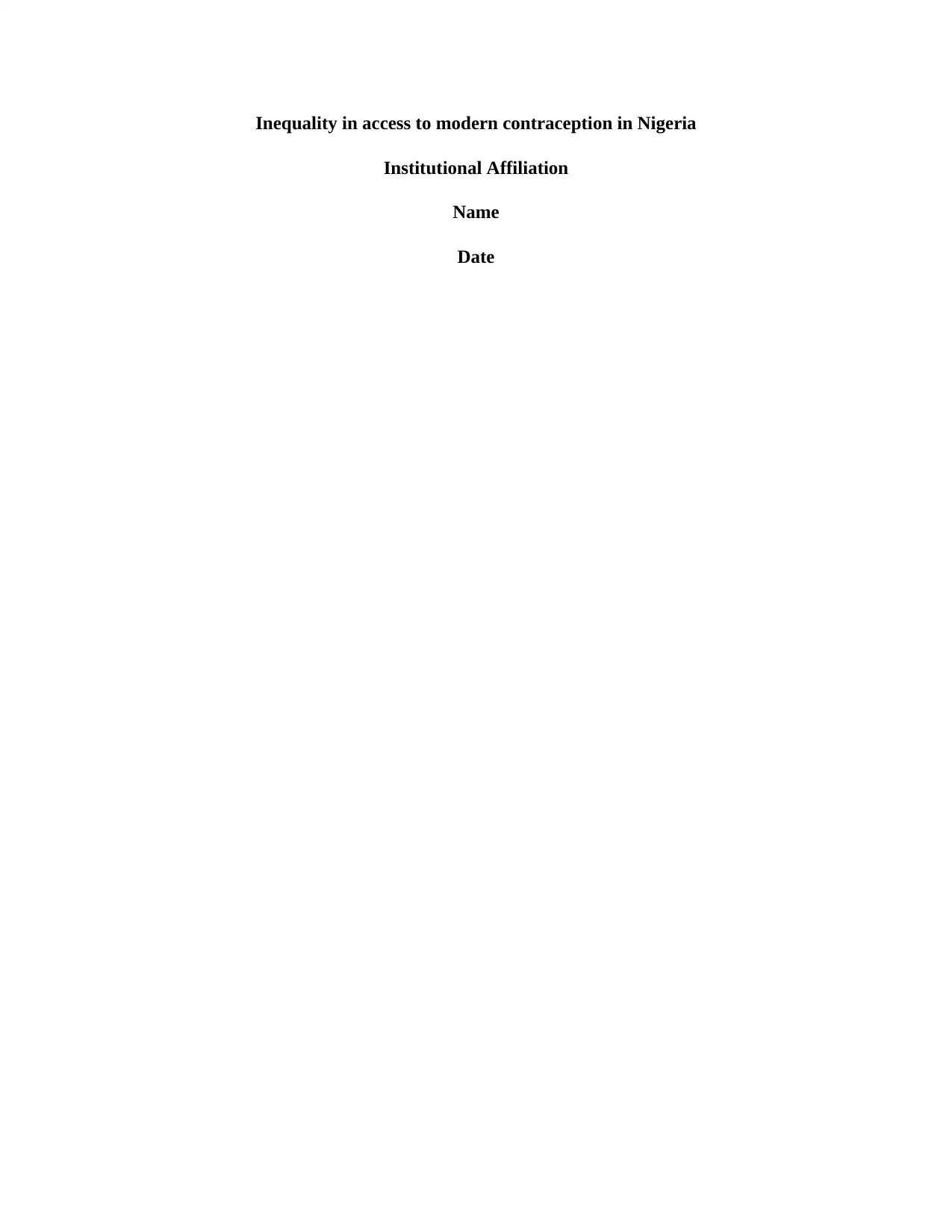
Inequality in access to modern contraception in Nigeria
Institutional Affiliation
Name
Date
Institutional Affiliation
Name
Date
Paraphrase This Document
Need a fresh take? Get an instant paraphrase of this document with our AI Paraphraser
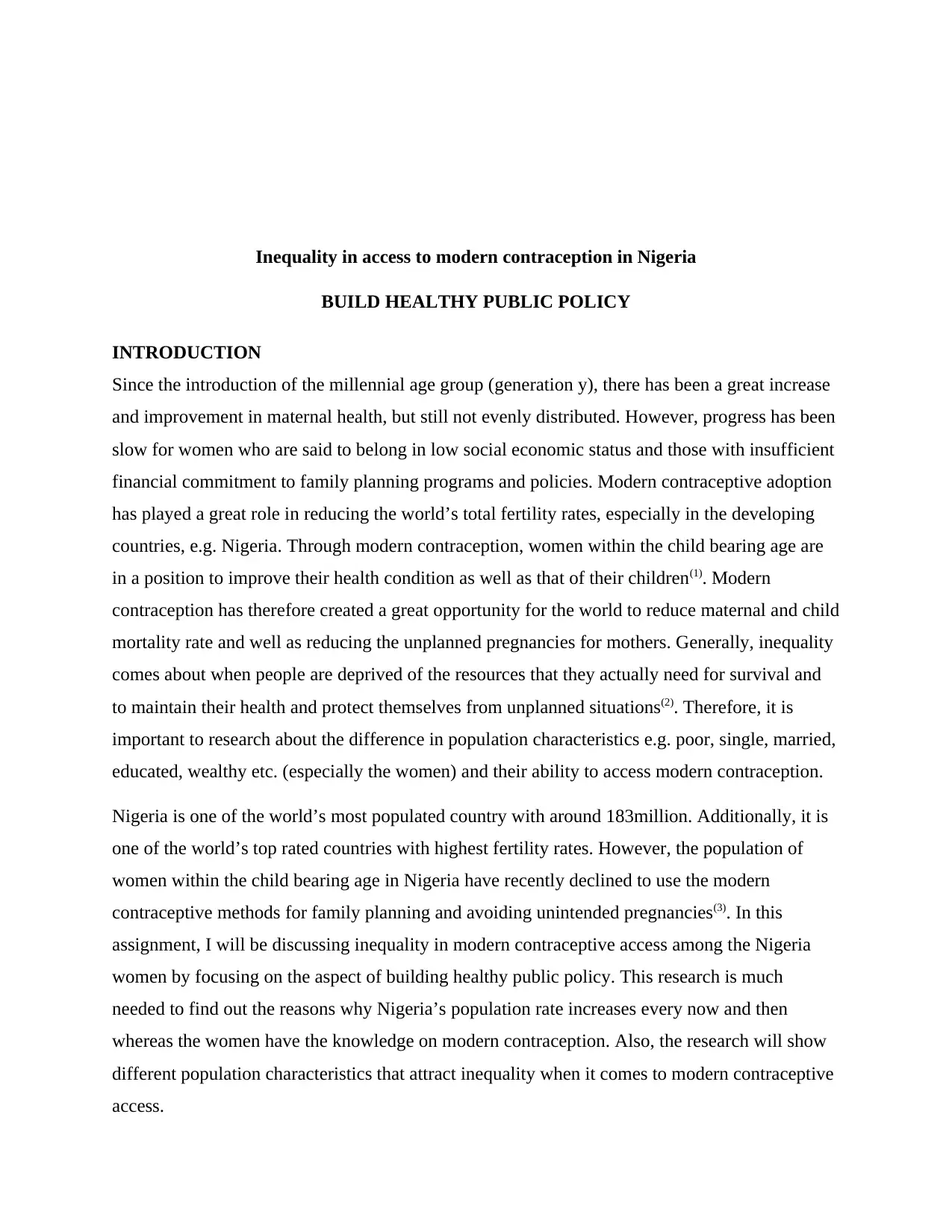
Inequality in access to modern contraception in Nigeria
BUILD HEALTHY PUBLIC POLICY
INTRODUCTION
Since the introduction of the millennial age group (generation y), there has been a great increase
and improvement in maternal health, but still not evenly distributed. However, progress has been
slow for women who are said to belong in low social economic status and those with insufficient
financial commitment to family planning programs and policies. Modern contraceptive adoption
has played a great role in reducing the world’s total fertility rates, especially in the developing
countries, e.g. Nigeria. Through modern contraception, women within the child bearing age are
in a position to improve their health condition as well as that of their children(1). Modern
contraception has therefore created a great opportunity for the world to reduce maternal and child
mortality rate and well as reducing the unplanned pregnancies for mothers. Generally, inequality
comes about when people are deprived of the resources that they actually need for survival and
to maintain their health and protect themselves from unplanned situations(2). Therefore, it is
important to research about the difference in population characteristics e.g. poor, single, married,
educated, wealthy etc. (especially the women) and their ability to access modern contraception.
Nigeria is one of the world’s most populated country with around 183million. Additionally, it is
one of the world’s top rated countries with highest fertility rates. However, the population of
women within the child bearing age in Nigeria have recently declined to use the modern
contraceptive methods for family planning and avoiding unintended pregnancies(3). In this
assignment, I will be discussing inequality in modern contraceptive access among the Nigeria
women by focusing on the aspect of building healthy public policy. This research is much
needed to find out the reasons why Nigeria’s population rate increases every now and then
whereas the women have the knowledge on modern contraception. Also, the research will show
different population characteristics that attract inequality when it comes to modern contraceptive
access.
BUILD HEALTHY PUBLIC POLICY
INTRODUCTION
Since the introduction of the millennial age group (generation y), there has been a great increase
and improvement in maternal health, but still not evenly distributed. However, progress has been
slow for women who are said to belong in low social economic status and those with insufficient
financial commitment to family planning programs and policies. Modern contraceptive adoption
has played a great role in reducing the world’s total fertility rates, especially in the developing
countries, e.g. Nigeria. Through modern contraception, women within the child bearing age are
in a position to improve their health condition as well as that of their children(1). Modern
contraception has therefore created a great opportunity for the world to reduce maternal and child
mortality rate and well as reducing the unplanned pregnancies for mothers. Generally, inequality
comes about when people are deprived of the resources that they actually need for survival and
to maintain their health and protect themselves from unplanned situations(2). Therefore, it is
important to research about the difference in population characteristics e.g. poor, single, married,
educated, wealthy etc. (especially the women) and their ability to access modern contraception.
Nigeria is one of the world’s most populated country with around 183million. Additionally, it is
one of the world’s top rated countries with highest fertility rates. However, the population of
women within the child bearing age in Nigeria have recently declined to use the modern
contraceptive methods for family planning and avoiding unintended pregnancies(3). In this
assignment, I will be discussing inequality in modern contraceptive access among the Nigeria
women by focusing on the aspect of building healthy public policy. This research is much
needed to find out the reasons why Nigeria’s population rate increases every now and then
whereas the women have the knowledge on modern contraception. Also, the research will show
different population characteristics that attract inequality when it comes to modern contraceptive
access.
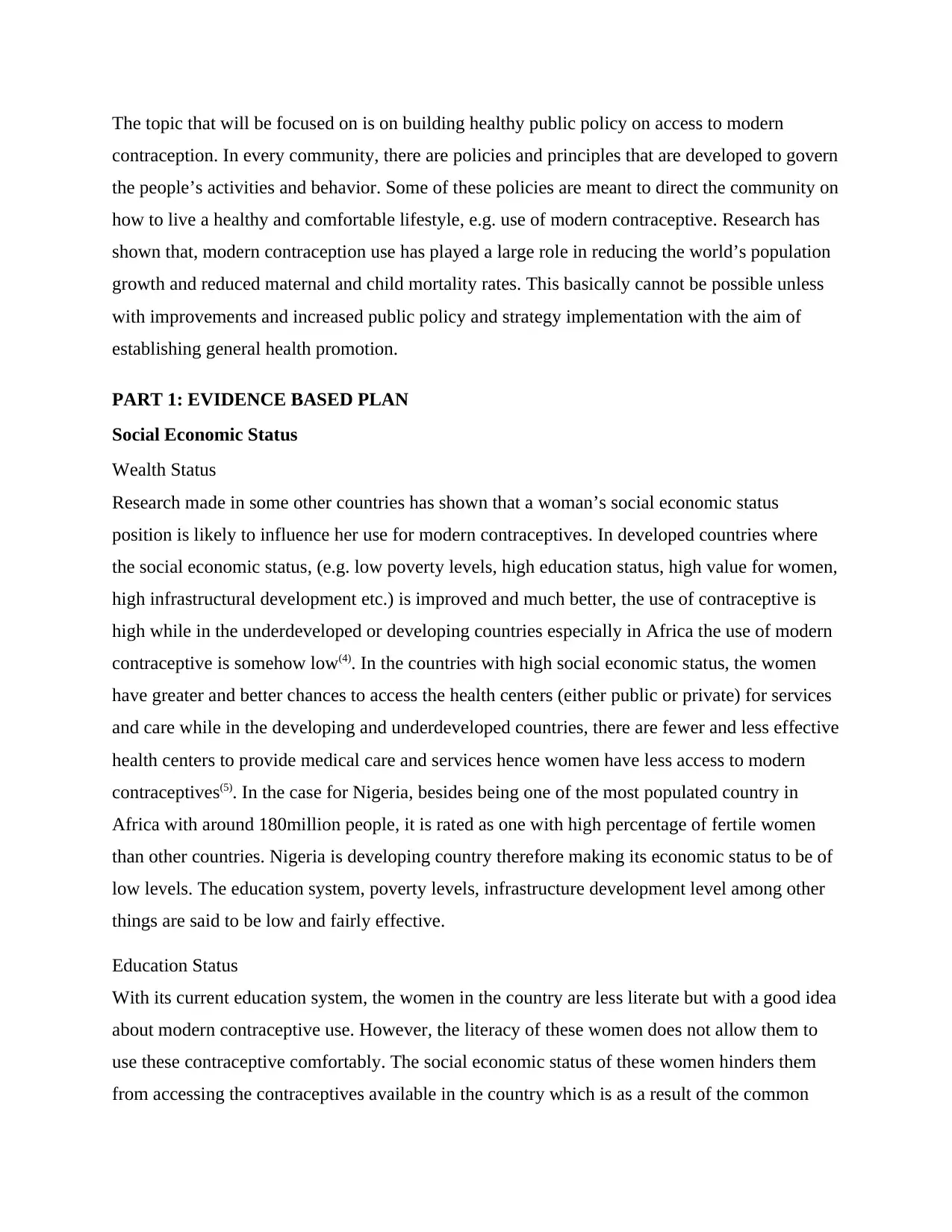
The topic that will be focused on is on building healthy public policy on access to modern
contraception. In every community, there are policies and principles that are developed to govern
the people’s activities and behavior. Some of these policies are meant to direct the community on
how to live a healthy and comfortable lifestyle, e.g. use of modern contraceptive. Research has
shown that, modern contraception use has played a large role in reducing the world’s population
growth and reduced maternal and child mortality rates. This basically cannot be possible unless
with improvements and increased public policy and strategy implementation with the aim of
establishing general health promotion.
PART 1: EVIDENCE BASED PLAN
Social Economic Status
Wealth Status
Research made in some other countries has shown that a woman’s social economic status
position is likely to influence her use for modern contraceptives. In developed countries where
the social economic status, (e.g. low poverty levels, high education status, high value for women,
high infrastructural development etc.) is improved and much better, the use of contraceptive is
high while in the underdeveloped or developing countries especially in Africa the use of modern
contraceptive is somehow low(4). In the countries with high social economic status, the women
have greater and better chances to access the health centers (either public or private) for services
and care while in the developing and underdeveloped countries, there are fewer and less effective
health centers to provide medical care and services hence women have less access to modern
contraceptives(5). In the case for Nigeria, besides being one of the most populated country in
Africa with around 180million people, it is rated as one with high percentage of fertile women
than other countries. Nigeria is developing country therefore making its economic status to be of
low levels. The education system, poverty levels, infrastructure development level among other
things are said to be low and fairly effective.
Education Status
With its current education system, the women in the country are less literate but with a good idea
about modern contraceptive use. However, the literacy of these women does not allow them to
use these contraceptive comfortably. The social economic status of these women hinders them
from accessing the contraceptives available in the country which is as a result of the common
contraception. In every community, there are policies and principles that are developed to govern
the people’s activities and behavior. Some of these policies are meant to direct the community on
how to live a healthy and comfortable lifestyle, e.g. use of modern contraceptive. Research has
shown that, modern contraception use has played a large role in reducing the world’s population
growth and reduced maternal and child mortality rates. This basically cannot be possible unless
with improvements and increased public policy and strategy implementation with the aim of
establishing general health promotion.
PART 1: EVIDENCE BASED PLAN
Social Economic Status
Wealth Status
Research made in some other countries has shown that a woman’s social economic status
position is likely to influence her use for modern contraceptives. In developed countries where
the social economic status, (e.g. low poverty levels, high education status, high value for women,
high infrastructural development etc.) is improved and much better, the use of contraceptive is
high while in the underdeveloped or developing countries especially in Africa the use of modern
contraceptive is somehow low(4). In the countries with high social economic status, the women
have greater and better chances to access the health centers (either public or private) for services
and care while in the developing and underdeveloped countries, there are fewer and less effective
health centers to provide medical care and services hence women have less access to modern
contraceptives(5). In the case for Nigeria, besides being one of the most populated country in
Africa with around 180million people, it is rated as one with high percentage of fertile women
than other countries. Nigeria is developing country therefore making its economic status to be of
low levels. The education system, poverty levels, infrastructure development level among other
things are said to be low and fairly effective.
Education Status
With its current education system, the women in the country are less literate but with a good idea
about modern contraceptive use. However, the literacy of these women does not allow them to
use these contraceptive comfortably. The social economic status of these women hinders them
from accessing the contraceptives available in the country which is as a result of the common
⊘ This is a preview!⊘
Do you want full access?
Subscribe today to unlock all pages.

Trusted by 1+ million students worldwide
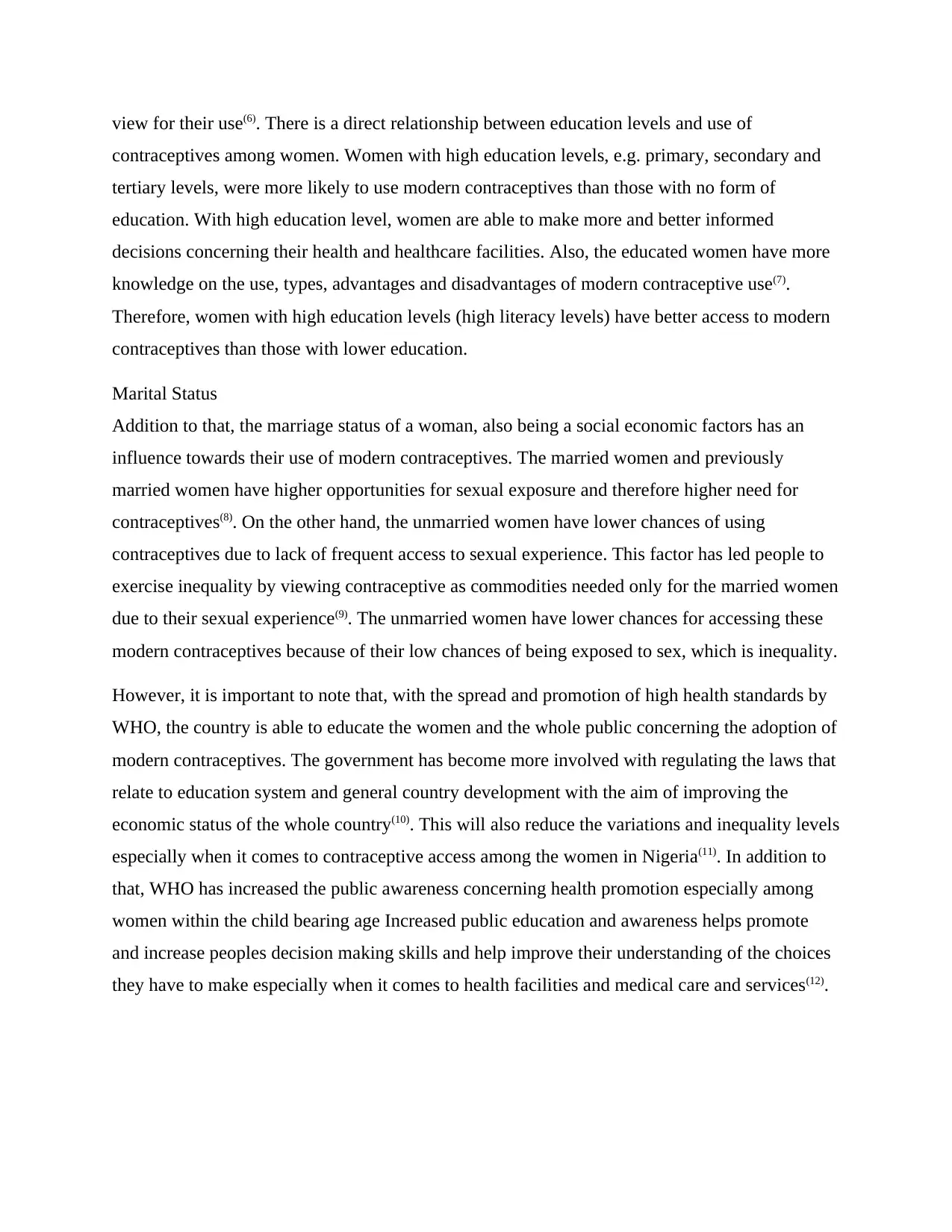
view for their use(6). There is a direct relationship between education levels and use of
contraceptives among women. Women with high education levels, e.g. primary, secondary and
tertiary levels, were more likely to use modern contraceptives than those with no form of
education. With high education level, women are able to make more and better informed
decisions concerning their health and healthcare facilities. Also, the educated women have more
knowledge on the use, types, advantages and disadvantages of modern contraceptive use(7).
Therefore, women with high education levels (high literacy levels) have better access to modern
contraceptives than those with lower education.
Marital Status
Addition to that, the marriage status of a woman, also being a social economic factors has an
influence towards their use of modern contraceptives. The married women and previously
married women have higher opportunities for sexual exposure and therefore higher need for
contraceptives(8). On the other hand, the unmarried women have lower chances of using
contraceptives due to lack of frequent access to sexual experience. This factor has led people to
exercise inequality by viewing contraceptive as commodities needed only for the married women
due to their sexual experience(9). The unmarried women have lower chances for accessing these
modern contraceptives because of their low chances of being exposed to sex, which is inequality.
However, it is important to note that, with the spread and promotion of high health standards by
WHO, the country is able to educate the women and the whole public concerning the adoption of
modern contraceptives. The government has become more involved with regulating the laws that
relate to education system and general country development with the aim of improving the
economic status of the whole country(10). This will also reduce the variations and inequality levels
especially when it comes to contraceptive access among the women in Nigeria(11). In addition to
that, WHO has increased the public awareness concerning health promotion especially among
women within the child bearing age Increased public education and awareness helps promote
and increase peoples decision making skills and help improve their understanding of the choices
they have to make especially when it comes to health facilities and medical care and services(12).
contraceptives among women. Women with high education levels, e.g. primary, secondary and
tertiary levels, were more likely to use modern contraceptives than those with no form of
education. With high education level, women are able to make more and better informed
decisions concerning their health and healthcare facilities. Also, the educated women have more
knowledge on the use, types, advantages and disadvantages of modern contraceptive use(7).
Therefore, women with high education levels (high literacy levels) have better access to modern
contraceptives than those with lower education.
Marital Status
Addition to that, the marriage status of a woman, also being a social economic factors has an
influence towards their use of modern contraceptives. The married women and previously
married women have higher opportunities for sexual exposure and therefore higher need for
contraceptives(8). On the other hand, the unmarried women have lower chances of using
contraceptives due to lack of frequent access to sexual experience. This factor has led people to
exercise inequality by viewing contraceptive as commodities needed only for the married women
due to their sexual experience(9). The unmarried women have lower chances for accessing these
modern contraceptives because of their low chances of being exposed to sex, which is inequality.
However, it is important to note that, with the spread and promotion of high health standards by
WHO, the country is able to educate the women and the whole public concerning the adoption of
modern contraceptives. The government has become more involved with regulating the laws that
relate to education system and general country development with the aim of improving the
economic status of the whole country(10). This will also reduce the variations and inequality levels
especially when it comes to contraceptive access among the women in Nigeria(11). In addition to
that, WHO has increased the public awareness concerning health promotion especially among
women within the child bearing age Increased public education and awareness helps promote
and increase peoples decision making skills and help improve their understanding of the choices
they have to make especially when it comes to health facilities and medical care and services(12).
Paraphrase This Document
Need a fresh take? Get an instant paraphrase of this document with our AI Paraphraser
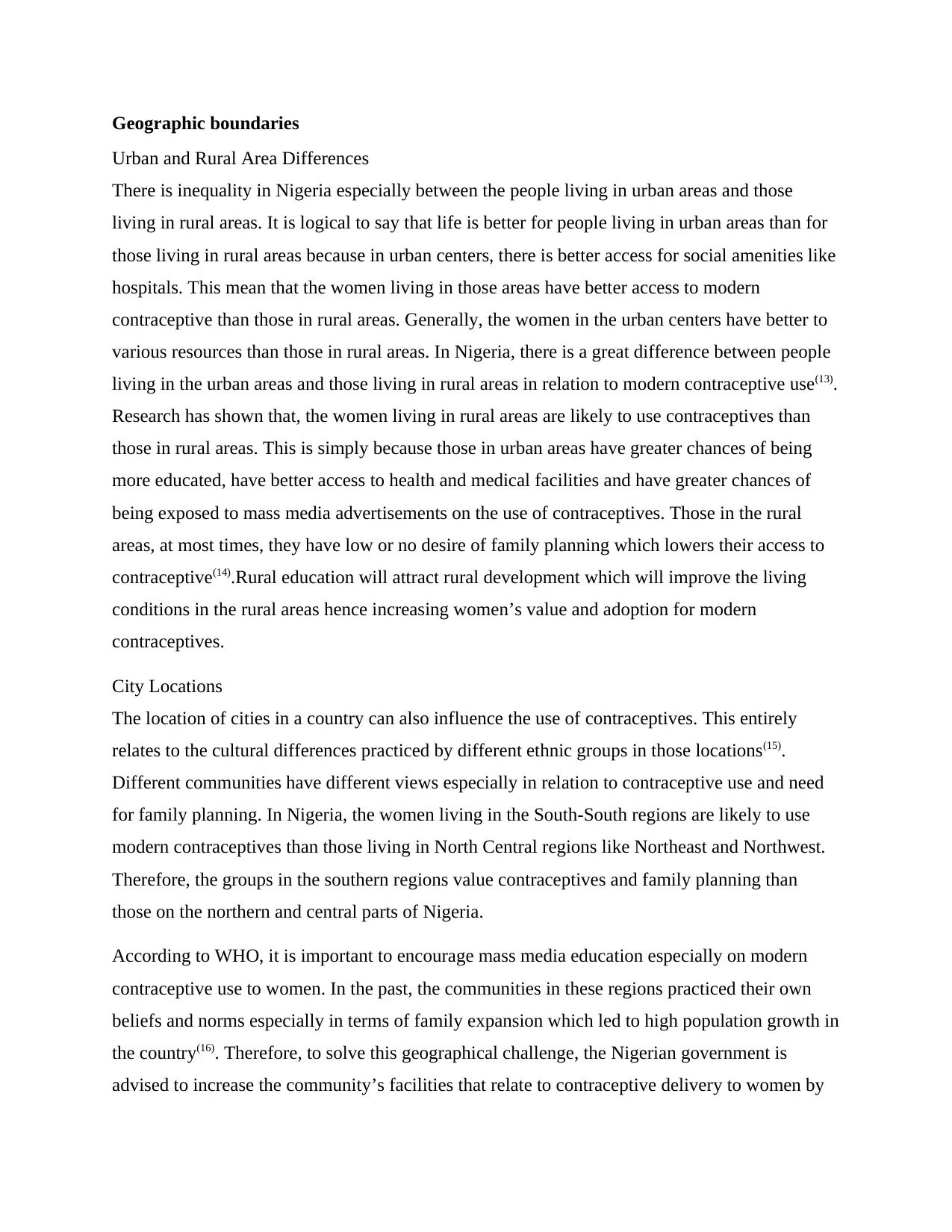
Geographic boundaries
Urban and Rural Area Differences
There is inequality in Nigeria especially between the people living in urban areas and those
living in rural areas. It is logical to say that life is better for people living in urban areas than for
those living in rural areas because in urban centers, there is better access for social amenities like
hospitals. This mean that the women living in those areas have better access to modern
contraceptive than those in rural areas. Generally, the women in the urban centers have better to
various resources than those in rural areas. In Nigeria, there is a great difference between people
living in the urban areas and those living in rural areas in relation to modern contraceptive use(13).
Research has shown that, the women living in rural areas are likely to use contraceptives than
those in rural areas. This is simply because those in urban areas have greater chances of being
more educated, have better access to health and medical facilities and have greater chances of
being exposed to mass media advertisements on the use of contraceptives. Those in the rural
areas, at most times, they have low or no desire of family planning which lowers their access to
contraceptive(14).Rural education will attract rural development which will improve the living
conditions in the rural areas hence increasing women’s value and adoption for modern
contraceptives.
City Locations
The location of cities in a country can also influence the use of contraceptives. This entirely
relates to the cultural differences practiced by different ethnic groups in those locations(15).
Different communities have different views especially in relation to contraceptive use and need
for family planning. In Nigeria, the women living in the South-South regions are likely to use
modern contraceptives than those living in North Central regions like Northeast and Northwest.
Therefore, the groups in the southern regions value contraceptives and family planning than
those on the northern and central parts of Nigeria.
According to WHO, it is important to encourage mass media education especially on modern
contraceptive use to women. In the past, the communities in these regions practiced their own
beliefs and norms especially in terms of family expansion which led to high population growth in
the country(16). Therefore, to solve this geographical challenge, the Nigerian government is
advised to increase the community’s facilities that relate to contraceptive delivery to women by
Urban and Rural Area Differences
There is inequality in Nigeria especially between the people living in urban areas and those
living in rural areas. It is logical to say that life is better for people living in urban areas than for
those living in rural areas because in urban centers, there is better access for social amenities like
hospitals. This mean that the women living in those areas have better access to modern
contraceptive than those in rural areas. Generally, the women in the urban centers have better to
various resources than those in rural areas. In Nigeria, there is a great difference between people
living in the urban areas and those living in rural areas in relation to modern contraceptive use(13).
Research has shown that, the women living in rural areas are likely to use contraceptives than
those in rural areas. This is simply because those in urban areas have greater chances of being
more educated, have better access to health and medical facilities and have greater chances of
being exposed to mass media advertisements on the use of contraceptives. Those in the rural
areas, at most times, they have low or no desire of family planning which lowers their access to
contraceptive(14).Rural education will attract rural development which will improve the living
conditions in the rural areas hence increasing women’s value and adoption for modern
contraceptives.
City Locations
The location of cities in a country can also influence the use of contraceptives. This entirely
relates to the cultural differences practiced by different ethnic groups in those locations(15).
Different communities have different views especially in relation to contraceptive use and need
for family planning. In Nigeria, the women living in the South-South regions are likely to use
modern contraceptives than those living in North Central regions like Northeast and Northwest.
Therefore, the groups in the southern regions value contraceptives and family planning than
those on the northern and central parts of Nigeria.
According to WHO, it is important to encourage mass media education especially on modern
contraceptive use to women. In the past, the communities in these regions practiced their own
beliefs and norms especially in terms of family expansion which led to high population growth in
the country(16). Therefore, to solve this geographical challenge, the Nigerian government is
advised to increase the community’s facilities that relate to contraceptive delivery to women by
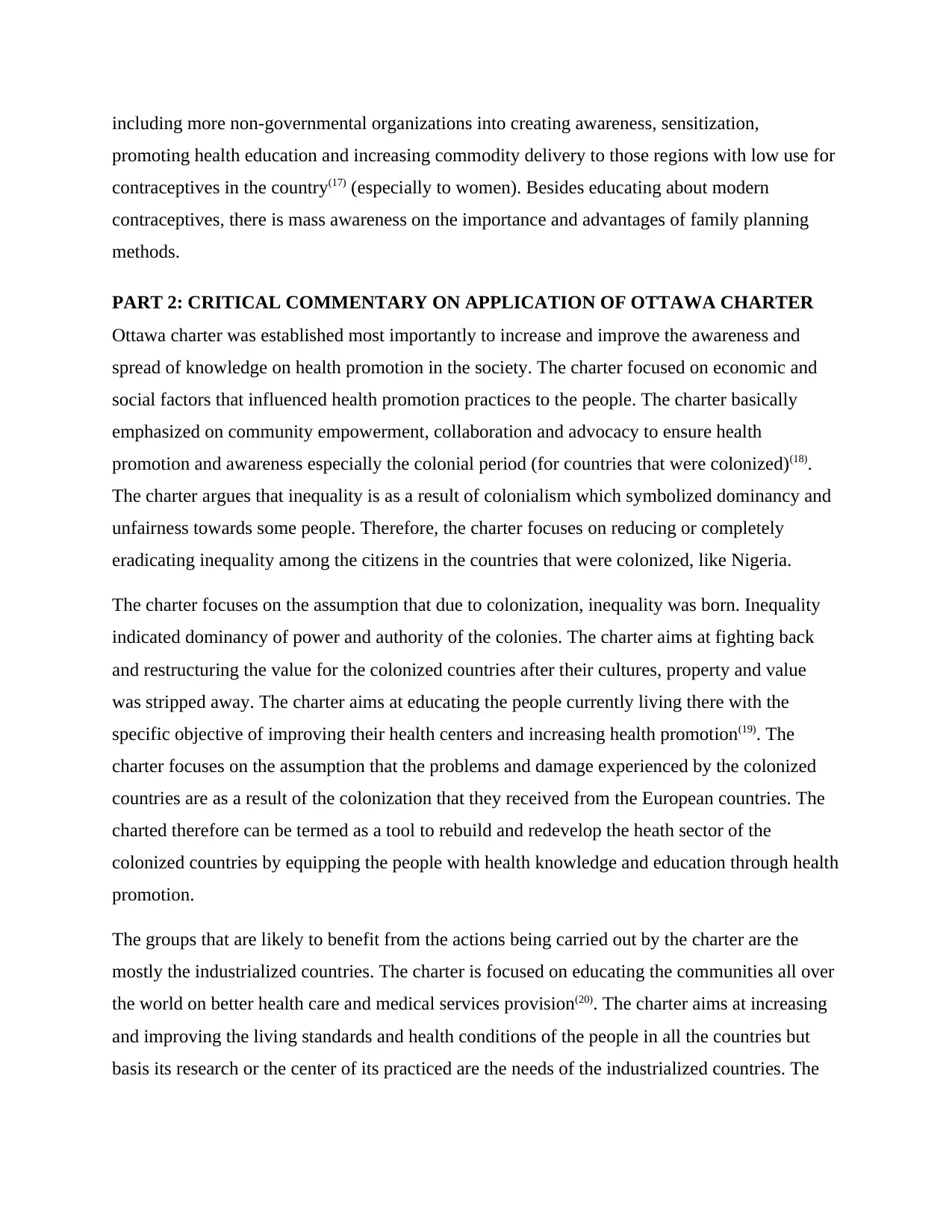
including more non-governmental organizations into creating awareness, sensitization,
promoting health education and increasing commodity delivery to those regions with low use for
contraceptives in the country(17) (especially to women). Besides educating about modern
contraceptives, there is mass awareness on the importance and advantages of family planning
methods.
PART 2: CRITICAL COMMENTARY ON APPLICATION OF OTTAWA CHARTER
Ottawa charter was established most importantly to increase and improve the awareness and
spread of knowledge on health promotion in the society. The charter focused on economic and
social factors that influenced health promotion practices to the people. The charter basically
emphasized on community empowerment, collaboration and advocacy to ensure health
promotion and awareness especially the colonial period (for countries that were colonized)(18).
The charter argues that inequality is as a result of colonialism which symbolized dominancy and
unfairness towards some people. Therefore, the charter focuses on reducing or completely
eradicating inequality among the citizens in the countries that were colonized, like Nigeria.
The charter focuses on the assumption that due to colonization, inequality was born. Inequality
indicated dominancy of power and authority of the colonies. The charter aims at fighting back
and restructuring the value for the colonized countries after their cultures, property and value
was stripped away. The charter aims at educating the people currently living there with the
specific objective of improving their health centers and increasing health promotion(19). The
charter focuses on the assumption that the problems and damage experienced by the colonized
countries are as a result of the colonization that they received from the European countries. The
charted therefore can be termed as a tool to rebuild and redevelop the heath sector of the
colonized countries by equipping the people with health knowledge and education through health
promotion.
The groups that are likely to benefit from the actions being carried out by the charter are the
mostly the industrialized countries. The charter is focused on educating the communities all over
the world on better health care and medical services provision(20). The charter aims at increasing
and improving the living standards and health conditions of the people in all the countries but
basis its research or the center of its practiced are the needs of the industrialized countries. The
promoting health education and increasing commodity delivery to those regions with low use for
contraceptives in the country(17) (especially to women). Besides educating about modern
contraceptives, there is mass awareness on the importance and advantages of family planning
methods.
PART 2: CRITICAL COMMENTARY ON APPLICATION OF OTTAWA CHARTER
Ottawa charter was established most importantly to increase and improve the awareness and
spread of knowledge on health promotion in the society. The charter focused on economic and
social factors that influenced health promotion practices to the people. The charter basically
emphasized on community empowerment, collaboration and advocacy to ensure health
promotion and awareness especially the colonial period (for countries that were colonized)(18).
The charter argues that inequality is as a result of colonialism which symbolized dominancy and
unfairness towards some people. Therefore, the charter focuses on reducing or completely
eradicating inequality among the citizens in the countries that were colonized, like Nigeria.
The charter focuses on the assumption that due to colonization, inequality was born. Inequality
indicated dominancy of power and authority of the colonies. The charter aims at fighting back
and restructuring the value for the colonized countries after their cultures, property and value
was stripped away. The charter aims at educating the people currently living there with the
specific objective of improving their health centers and increasing health promotion(19). The
charter focuses on the assumption that the problems and damage experienced by the colonized
countries are as a result of the colonization that they received from the European countries. The
charted therefore can be termed as a tool to rebuild and redevelop the heath sector of the
colonized countries by equipping the people with health knowledge and education through health
promotion.
The groups that are likely to benefit from the actions being carried out by the charter are the
mostly the industrialized countries. The charter is focused on educating the communities all over
the world on better health care and medical services provision(20). The charter aims at increasing
and improving the living standards and health conditions of the people in all the countries but
basis its research or the center of its practiced are the needs of the industrialized countries. The
⊘ This is a preview!⊘
Do you want full access?
Subscribe today to unlock all pages.

Trusted by 1+ million students worldwide
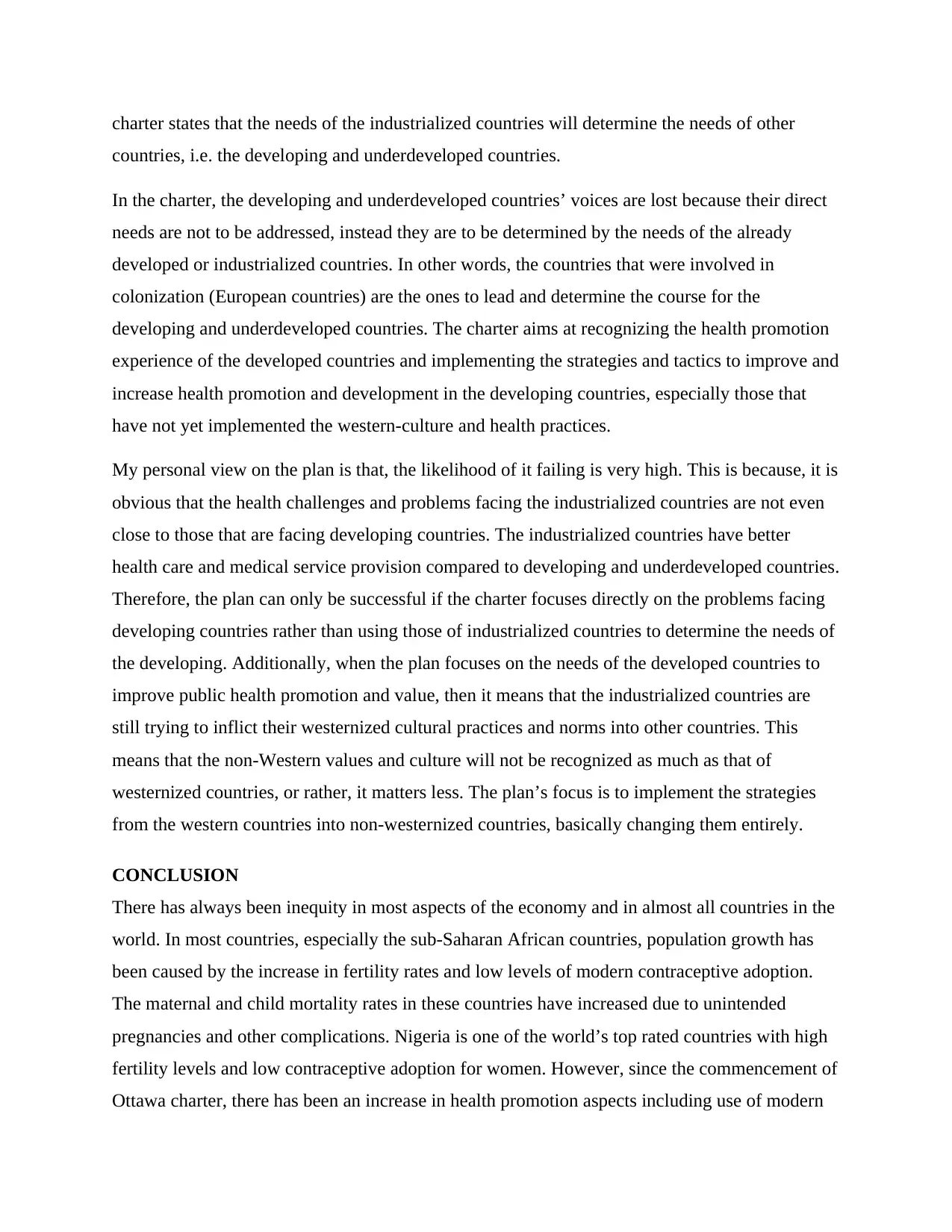
charter states that the needs of the industrialized countries will determine the needs of other
countries, i.e. the developing and underdeveloped countries.
In the charter, the developing and underdeveloped countries’ voices are lost because their direct
needs are not to be addressed, instead they are to be determined by the needs of the already
developed or industrialized countries. In other words, the countries that were involved in
colonization (European countries) are the ones to lead and determine the course for the
developing and underdeveloped countries. The charter aims at recognizing the health promotion
experience of the developed countries and implementing the strategies and tactics to improve and
increase health promotion and development in the developing countries, especially those that
have not yet implemented the western-culture and health practices.
My personal view on the plan is that, the likelihood of it failing is very high. This is because, it is
obvious that the health challenges and problems facing the industrialized countries are not even
close to those that are facing developing countries. The industrialized countries have better
health care and medical service provision compared to developing and underdeveloped countries.
Therefore, the plan can only be successful if the charter focuses directly on the problems facing
developing countries rather than using those of industrialized countries to determine the needs of
the developing. Additionally, when the plan focuses on the needs of the developed countries to
improve public health promotion and value, then it means that the industrialized countries are
still trying to inflict their westernized cultural practices and norms into other countries. This
means that the non-Western values and culture will not be recognized as much as that of
westernized countries, or rather, it matters less. The plan’s focus is to implement the strategies
from the western countries into non-westernized countries, basically changing them entirely.
CONCLUSION
There has always been inequity in most aspects of the economy and in almost all countries in the
world. In most countries, especially the sub-Saharan African countries, population growth has
been caused by the increase in fertility rates and low levels of modern contraceptive adoption.
The maternal and child mortality rates in these countries have increased due to unintended
pregnancies and other complications. Nigeria is one of the world’s top rated countries with high
fertility levels and low contraceptive adoption for women. However, since the commencement of
Ottawa charter, there has been an increase in health promotion aspects including use of modern
countries, i.e. the developing and underdeveloped countries.
In the charter, the developing and underdeveloped countries’ voices are lost because their direct
needs are not to be addressed, instead they are to be determined by the needs of the already
developed or industrialized countries. In other words, the countries that were involved in
colonization (European countries) are the ones to lead and determine the course for the
developing and underdeveloped countries. The charter aims at recognizing the health promotion
experience of the developed countries and implementing the strategies and tactics to improve and
increase health promotion and development in the developing countries, especially those that
have not yet implemented the western-culture and health practices.
My personal view on the plan is that, the likelihood of it failing is very high. This is because, it is
obvious that the health challenges and problems facing the industrialized countries are not even
close to those that are facing developing countries. The industrialized countries have better
health care and medical service provision compared to developing and underdeveloped countries.
Therefore, the plan can only be successful if the charter focuses directly on the problems facing
developing countries rather than using those of industrialized countries to determine the needs of
the developing. Additionally, when the plan focuses on the needs of the developed countries to
improve public health promotion and value, then it means that the industrialized countries are
still trying to inflict their westernized cultural practices and norms into other countries. This
means that the non-Western values and culture will not be recognized as much as that of
westernized countries, or rather, it matters less. The plan’s focus is to implement the strategies
from the western countries into non-westernized countries, basically changing them entirely.
CONCLUSION
There has always been inequity in most aspects of the economy and in almost all countries in the
world. In most countries, especially the sub-Saharan African countries, population growth has
been caused by the increase in fertility rates and low levels of modern contraceptive adoption.
The maternal and child mortality rates in these countries have increased due to unintended
pregnancies and other complications. Nigeria is one of the world’s top rated countries with high
fertility levels and low contraceptive adoption for women. However, since the commencement of
Ottawa charter, there has been an increase in health promotion aspects including use of modern
Paraphrase This Document
Need a fresh take? Get an instant paraphrase of this document with our AI Paraphraser

contraceptive by women. This has reduced the inequality aspects that was being exercised long
before the charter was introduced especially due to social economic issues of women.
REFERENCES
1. Adebowale SA, Adeoye IA, Palamuleni ME. Contraceptive use among Nigerian women
with no fertility intention: interaction amid potential causative factors. Etude de la
Population Africaine. 2013 Jul 1;27(2):127.
2. Akinyemi A, Adedini S, Hounton S, Akinlo A, Adedeji O, Adonri O, Friedman H,
Shiferaw S, Maïga A, Amouzou A, Barros AJ. Contraceptive use and distribution of
high-risk births in Nigeria: a sub-national analysis. Global health action. 2015 Dec
1;8(1):29745.
3. Balogun MO, Owoaje ET. Contraceptive use among female traders in Ibadan, Nigeria.
Tropical Journal of Obstetrics and Gynaecology. 2013;30(2):63-71.
4. Creanga AA, Gillespie D, Karklins S, Tsui AO. Low use of contraception among poor
women in Africa: an equity issue. Bulletin of the World Health Organization. 2011
Apr;89(4):258-66.
5. Gakidou E, Vayena E. Use of modern contraception by the poor is falling behind. PLoS
Medicine. 2007 Feb 6;4(2):e31.
6. Gillespie D, Ahmed S, Tsui A, Radloff S. Unwanted fertility among the poor: an
inequity?. Bulletin of the World Health Organization. 2007 Feb;85(2):100-7.
7. Austin A. Unmet contraceptive need among married Nigerian women: an examination of
trends and drivers. Contraception. 2015 Jan 31;91(1):31-8.
8. Hounton S, Barros AJ, Amouzou A, Shiferaw S, Maïga A, Akinyemi A, Friedman H,
Koroma D. Patterns and trends of contraceptive use among sexually active adolescents in
Burkina Faso, Ethiopia, and Nigeria: evidence from cross-sectional studies. Global health
action. 2015 Dec 1;8(1):29737.
9. Adebowale AS, Gbadebo B, Afolabi FR. Wealth index, empowerment and modern
contraceptive use among married women in Nigeria: are they interrelated?. Journal of
Public Health. 2016 Oct 1;24(5):415-26.
before the charter was introduced especially due to social economic issues of women.
REFERENCES
1. Adebowale SA, Adeoye IA, Palamuleni ME. Contraceptive use among Nigerian women
with no fertility intention: interaction amid potential causative factors. Etude de la
Population Africaine. 2013 Jul 1;27(2):127.
2. Akinyemi A, Adedini S, Hounton S, Akinlo A, Adedeji O, Adonri O, Friedman H,
Shiferaw S, Maïga A, Amouzou A, Barros AJ. Contraceptive use and distribution of
high-risk births in Nigeria: a sub-national analysis. Global health action. 2015 Dec
1;8(1):29745.
3. Balogun MO, Owoaje ET. Contraceptive use among female traders in Ibadan, Nigeria.
Tropical Journal of Obstetrics and Gynaecology. 2013;30(2):63-71.
4. Creanga AA, Gillespie D, Karklins S, Tsui AO. Low use of contraception among poor
women in Africa: an equity issue. Bulletin of the World Health Organization. 2011
Apr;89(4):258-66.
5. Gakidou E, Vayena E. Use of modern contraception by the poor is falling behind. PLoS
Medicine. 2007 Feb 6;4(2):e31.
6. Gillespie D, Ahmed S, Tsui A, Radloff S. Unwanted fertility among the poor: an
inequity?. Bulletin of the World Health Organization. 2007 Feb;85(2):100-7.
7. Austin A. Unmet contraceptive need among married Nigerian women: an examination of
trends and drivers. Contraception. 2015 Jan 31;91(1):31-8.
8. Hounton S, Barros AJ, Amouzou A, Shiferaw S, Maïga A, Akinyemi A, Friedman H,
Koroma D. Patterns and trends of contraceptive use among sexually active adolescents in
Burkina Faso, Ethiopia, and Nigeria: evidence from cross-sectional studies. Global health
action. 2015 Dec 1;8(1):29737.
9. Adebowale AS, Gbadebo B, Afolabi FR. Wealth index, empowerment and modern
contraceptive use among married women in Nigeria: are they interrelated?. Journal of
Public Health. 2016 Oct 1;24(5):415-26.
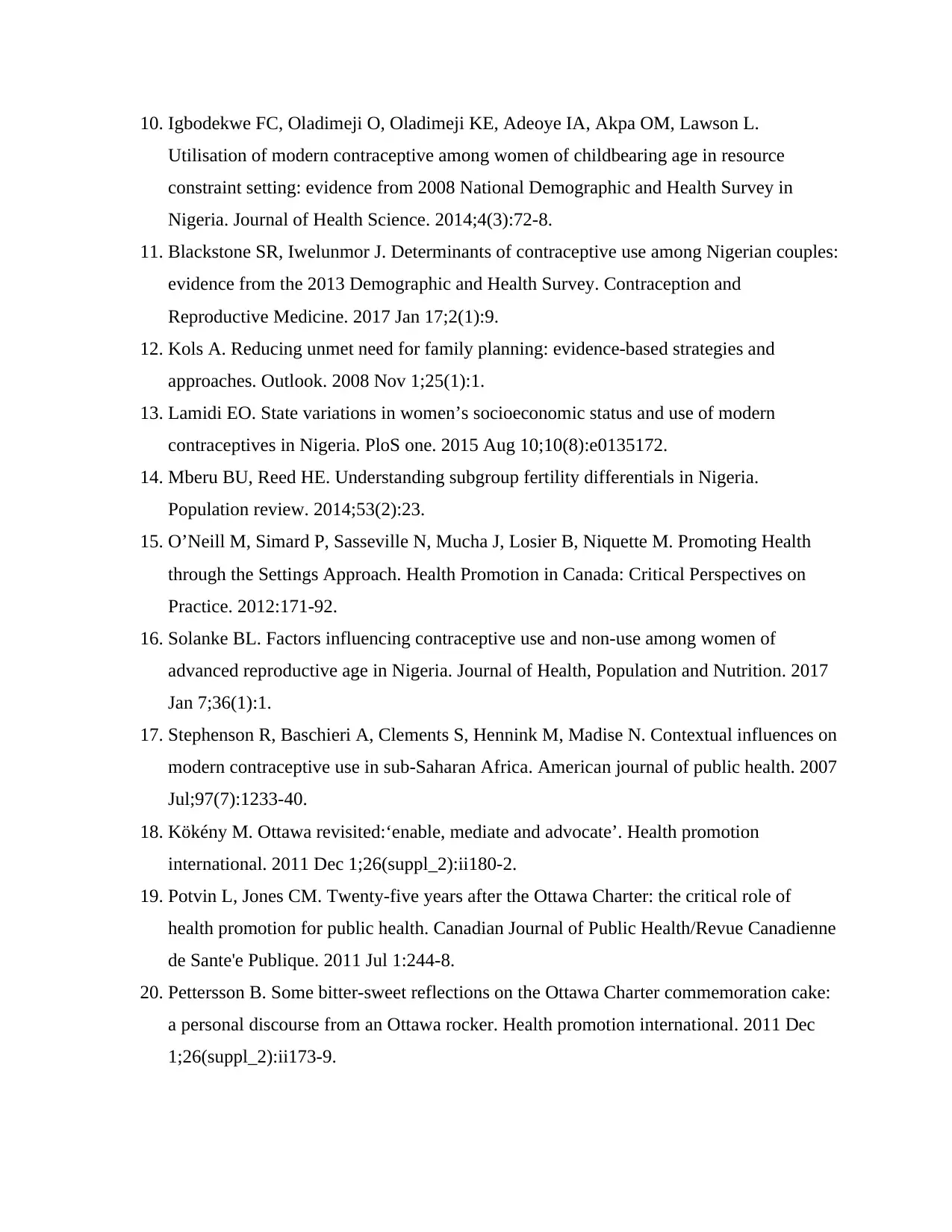
10. Igbodekwe FC, Oladimeji O, Oladimeji KE, Adeoye IA, Akpa OM, Lawson L.
Utilisation of modern contraceptive among women of childbearing age in resource
constraint setting: evidence from 2008 National Demographic and Health Survey in
Nigeria. Journal of Health Science. 2014;4(3):72-8.
11. Blackstone SR, Iwelunmor J. Determinants of contraceptive use among Nigerian couples:
evidence from the 2013 Demographic and Health Survey. Contraception and
Reproductive Medicine. 2017 Jan 17;2(1):9.
12. Kols A. Reducing unmet need for family planning: evidence-based strategies and
approaches. Outlook. 2008 Nov 1;25(1):1.
13. Lamidi EO. State variations in women’s socioeconomic status and use of modern
contraceptives in Nigeria. PloS one. 2015 Aug 10;10(8):e0135172.
14. Mberu BU, Reed HE. Understanding subgroup fertility differentials in Nigeria.
Population review. 2014;53(2):23.
15. O’Neill M, Simard P, Sasseville N, Mucha J, Losier B, Niquette M. Promoting Health
through the Settings Approach. Health Promotion in Canada: Critical Perspectives on
Practice. 2012:171-92.
16. Solanke BL. Factors influencing contraceptive use and non-use among women of
advanced reproductive age in Nigeria. Journal of Health, Population and Nutrition. 2017
Jan 7;36(1):1.
17. Stephenson R, Baschieri A, Clements S, Hennink M, Madise N. Contextual influences on
modern contraceptive use in sub-Saharan Africa. American journal of public health. 2007
Jul;97(7):1233-40.
18. Kökény M. Ottawa revisited:‘enable, mediate and advocate’. Health promotion
international. 2011 Dec 1;26(suppl_2):ii180-2.
19. Potvin L, Jones CM. Twenty-five years after the Ottawa Charter: the critical role of
health promotion for public health. Canadian Journal of Public Health/Revue Canadienne
de Sante'e Publique. 2011 Jul 1:244-8.
20. Pettersson B. Some bitter-sweet reflections on the Ottawa Charter commemoration cake:
a personal discourse from an Ottawa rocker. Health promotion international. 2011 Dec
1;26(suppl_2):ii173-9.
Utilisation of modern contraceptive among women of childbearing age in resource
constraint setting: evidence from 2008 National Demographic and Health Survey in
Nigeria. Journal of Health Science. 2014;4(3):72-8.
11. Blackstone SR, Iwelunmor J. Determinants of contraceptive use among Nigerian couples:
evidence from the 2013 Demographic and Health Survey. Contraception and
Reproductive Medicine. 2017 Jan 17;2(1):9.
12. Kols A. Reducing unmet need for family planning: evidence-based strategies and
approaches. Outlook. 2008 Nov 1;25(1):1.
13. Lamidi EO. State variations in women’s socioeconomic status and use of modern
contraceptives in Nigeria. PloS one. 2015 Aug 10;10(8):e0135172.
14. Mberu BU, Reed HE. Understanding subgroup fertility differentials in Nigeria.
Population review. 2014;53(2):23.
15. O’Neill M, Simard P, Sasseville N, Mucha J, Losier B, Niquette M. Promoting Health
through the Settings Approach. Health Promotion in Canada: Critical Perspectives on
Practice. 2012:171-92.
16. Solanke BL. Factors influencing contraceptive use and non-use among women of
advanced reproductive age in Nigeria. Journal of Health, Population and Nutrition. 2017
Jan 7;36(1):1.
17. Stephenson R, Baschieri A, Clements S, Hennink M, Madise N. Contextual influences on
modern contraceptive use in sub-Saharan Africa. American journal of public health. 2007
Jul;97(7):1233-40.
18. Kökény M. Ottawa revisited:‘enable, mediate and advocate’. Health promotion
international. 2011 Dec 1;26(suppl_2):ii180-2.
19. Potvin L, Jones CM. Twenty-five years after the Ottawa Charter: the critical role of
health promotion for public health. Canadian Journal of Public Health/Revue Canadienne
de Sante'e Publique. 2011 Jul 1:244-8.
20. Pettersson B. Some bitter-sweet reflections on the Ottawa Charter commemoration cake:
a personal discourse from an Ottawa rocker. Health promotion international. 2011 Dec
1;26(suppl_2):ii173-9.
⊘ This is a preview!⊘
Do you want full access?
Subscribe today to unlock all pages.

Trusted by 1+ million students worldwide
1 out of 9
Related Documents
Your All-in-One AI-Powered Toolkit for Academic Success.
+13062052269
info@desklib.com
Available 24*7 on WhatsApp / Email
![[object Object]](/_next/static/media/star-bottom.7253800d.svg)
Unlock your academic potential
Copyright © 2020–2025 A2Z Services. All Rights Reserved. Developed and managed by ZUCOL.





